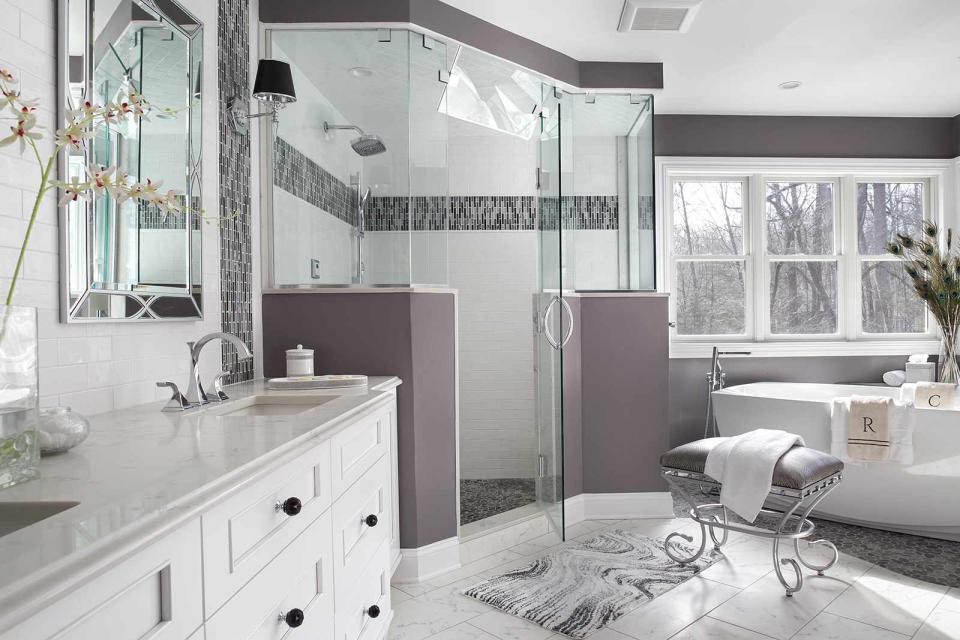What Is a Steam Shower? A Guide to the Popular Bathroom Upgrade
Everything you need to know about the hot home wellness feature.

Peter Rymwid / Designer: Sharon Sherman / Courtesy of MrSteam
Steam showers were everywhere at the Kitchen and Bath Industry show earlier this year, and it’s no surprise. Recent home trends have prioritized maximizing space while providing personal wellness benefits—and steam showers are an excellent example of how to do both.
”Steam is humankind's oldest therapy, dating to the Greek and Roman times. Despite its long history, steam continues to surprise people with its wide range of health and wellness benefits,” says Martha Orellana, vice president at MrSteam.
Here, we explore what steam showers are, their benefits, and things you should consider before adding a steam shower to your own home.
What Is a Steam Shower?
“A steam shower by definition is simply a fully enclosed space that delivers steam,” says Orellana. Steam showers rely on a steam generator, located outside the shower, to produce steam. “With the touch of a button or screen, the steam generator heats water until it vaporizes and then quickly releases the resulting steam into a steam head within the shower enclosure.”
“Steam showers can fit into nearly any traditional shower if enclosed, insulated, and sealed,” says Orellana. A steam shower can be incorporated into an existing traditional shower and can be outfitted to offer experiences like aromatherapy, chromatherapy, and music therapy.
Differences Between a Steam Shower and Traditional Shower
If you’ve ever wiped condensation off the bathroom mirror, you know that traditional showers do create steam. However, this isn’t the same as a steam shower. “While traditional showers may release some steam, they are less effective than a fully immersive steam shower system from a wellness perspective,” says Orellana. A steam shower is designed to be fully enclosed to capture the steam inside the shower, whereas a traditional shower typically has openings that release steam into the rest of the bathroom.
Related: What Is a Wet Room? How to Tell If This Bathroom Design Is Right for You

TRIA GIOVAN
Differences Between a Steam Shower and Sauna
Although both amenities sound hot and relaxing, saunas and steam showers provide quite different experiences.
A sauna generates its heat from a stove inside the space, while a steam shower relies on a steam generator outside the shower. They're also aesthetically different. While steam showers can be inside a traditional shower and bathroom footprint, a sauna requires its own room.
“Saunas are traditionally constructed from kiln-dried wood (often cedar or spruce) that can withstand much higher temperatures and lower humidity,” says Orellana. “On the other hand, steam showers are constructed from ceramic tile, natural stone, glass blocks, or other waterproof, nonporous materials that are conducive to a moist environment.”
Perhaps the biggest difference between saunas and steam showers is the heat itself. “The type of heat differentiates a sauna from a steam shower. Saunas deliver dry heat therapy while steam showers offer wet heat therapy,” says Orellana. “Sauna temperatures range between 160°F and 200°F with very little humidity. Steam showers range from 105°F to 115°F with nearly 100% humidity,” she says.
Steam Shower Installation
Steam showers are often incorporated as part of a traditional shower, and may even be added to an existing space with no need for a major renovation. However, steam showers do have some very specific requirements that need to be met.
“For the steam shower to function correctly, it must be installed in an enclosed, water- and vapor-tight space,” says Orellana. “The steam room should have no heating, venting, or air-conditioning components.” Any windows in the shower should be double-paned, all light fixtures must be vapor-sealed, and the ceiling height should be between 7 and 8 feet. As for the steam generator, Orellana says it should be placed within 60 feet of the steam shower and should have at least a foot of space around it to allow for servicing.
Also good to know: Large format tiles or slab walls are an especially good choice for shower surrounds because the larger formats collect less condensation.

Benefits of Steam Showers
Wellness
According to Jamie Gold, a Certified Kitchen and Bath Designer and a Wellness Design Consultant, the pandemic made many people realize how home environments can contribute to well-being. As a result, steam technology for the home has become more popular and well-known.
“Homeowners have experienced their benefits at the gym or resorts and want those benefits at home, where they’re spending more time now,” says Gold. “It can improve your physical (respiratory, circulatory, skin, joints, etc.) and mental (stress release, relaxation) health.”
Related: 2023 Is the Year of the Shower (Sorry, Bathtubs)
Real Estate Value
According to Gold, it's harder to move into a bigger or better home in the current real estate market—instead, homeowners are improving the spaces they have. She says steam showers are gaining attention as one of these improvement projects, in part because they add value to your home.
“Homebuyers are increasingly willing to pay a premium for quality features, like steam showers, that support their wellness goals,” says Orellana, citing a Zillow study that found steam showers can increase the value of a home by as much as 31%.
Environmental Factors
For those who like a long hot shower or soak, steam showers have some pretty impressive statistics that will help you feel alright about your water and energy consumption. According to Orellana, steam showers use “about two gallons of water for a 20-minute steam session, whereas a 20-minute bath using a traditional whirlpool or soaking tub can use 80 gallons of water.”
In addition, Orellana says steam showers use less water than a regular shower or bath, requiring less energy to heat. “That's why a home steam shower is a sustainable choice that can reduce your energy bills if you regularly take long showers or baths to unwind,” says Orellana.

Edmund Barr
Steam Shower Considerations
Design and Installation
While you might feel confident DIYing some or all of a traditional shower, steam showers are more complicated; it’s not something you should go alone. “This is also a project for which you definitely want an experienced plumbing contractor to avoid the mold issues that can arise from an improperly installed system,” says Gold. Since steam showers are not totally common, you might need to look around for the right pro.
The same is true for design. It should account for installation specifics required for steam showers, and not every designer will be familiar with the topic. You’ll also need space to accommodate the steam generator.
Cost
Things like size, surface materials, and architectural features impact the cost of any shower. Steam showers, however, do have additional costs, such as the steam head, generator, controls, and installation costs.
Maintenance
“There is maintenance involved in keeping it running clean, more so than with a regular shower,” says Gold. Certainly, all showers need to be cleaned and may require repairs or fixture replacements, but with a generator and other components—especially elements that aren't easy to troubleshoot or DIY—maintenance is a significant consideration.
Use
Steam showers might sound appealing, but before you go investing the resources in creating this at-home spa experience, really think about if it fits in your lifestyle. “Harried professionals and parents may imagine themselves enjoying a nightly interlude in the mist, while the reality of deadlines, kids, and other demands on their time means a standard shower is the norm and steam the exception,” says Gold.
Personal Health
Gold cautions against self-prescribing a steam shower for addressing physical conditions. Before investing, consider checking in with your doctor. “If your interest in adding a steam shower is to address a physical condition, I definitely recommend speaking with your physician before proceeding,” says Gold. Your doctor may have advice on how to utilize a steam shower, but they may also have warnings to help protect you if it’s not great for your personal health.
For more Better Homes & Gardens news, make sure to sign up for our newsletter!
Read the original article on Better Homes & Gardens.

